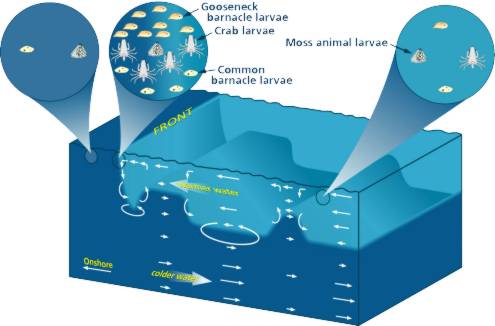|
|
What we do, in plain words
Stories (external links):
'Waves
within waves', by Leslie Baehr
'Rites
of passage for juvenile marine life', by J. Pineda
and A. Nevala
'On
the trail of an invader', by A. Gage
'Hannibal Sea Mount' by Brett Kuxhausen
'Swarming Red Crabs Documented on Video' by WHOI Media
Relations Office
Larval Transport by Internal Bores
Jesús Pineda
(Reproduced from WHOI
1998 Annual Report) (Complete
reference)
New generations of bottom
dwelling coastal marine animals face a complication on
their way to establishing new colonies. The early life
stages of such organisms as clams, mussels, shrimp, and
barnacles live suspended in the water, drifting at the
mercy of ocean currents in a "larval phase" that
generally lasts a few weeks. At the end of it, the
larvae must find a suitable habitat where they can grow
into adults and complete their life cycles.
Because ocean currents
disperse the larvae far from their birthplaces, they may
find themselves several miles offshore in deep water
just when they are ready to settle in the shallow
coastal water – a waste of larvae because they will not
survive in this situation.
After several weeks
suspended in the ocean, the probability of a larva
returning to its birthplace must be minimal, and the
abundance of the colonizers at a given site is uncoupled
from the living conditions of the adults. A site with no
natural enemies and rich in food may he vacant because
currents do not bring larvae, or, on the other hand, a
sub-optimal habitat with scarce food may contain a large
number of organisms if currents bring many larvae.
Knowledge of ocean currents that return the larvae to
coastal habitats is therefore key to understanding the
maintenance and dynamics of coastal species.
Understanding larval transport is also important for
managing fisheries and designing marine reserves. For
example, it would he futile to preserve a coastal site
that contains many adults if their larvae are all wasted
because current circulation at that site carries all the
larvae offshore.

Processes that influence the
population abundance of coastal bottom-dwelling
organisms, with a barnacle as example. The number of
larvae is larger than the number of adults, as each
adult produces a myriad of larvae. Larvae are often
found offshore, and before they can settle successfully
at the coast, several conditions must be fulfilled. In
each case, the proportion of larvae moving to the next
set of processes is smaller. Small changes in the
proportion of larvae that pass from one step to the next
can produce large population changes.
Much of my research focuses
on studying the various biological and physical
phenomena involved in larval transport by internal tidal
bores. When waves traveling at the surface of the ocean
approach the beach, they "feel the bottom," break and
produce a surge of surf running upslope. Internal
(subsurface) waves, which are also ubiquitous, but
s1ower and much larger than surface waves, also break
when they shoal, producing internal surf. Rather than
propagating along the air-sea interface internal waves
propagate along the interfaces of layers of water of
different temperature and salinity that are found in
most oceans. These internal tidal bores or breaking
internal waves often occur about every 12.4 or 24 hours.
Recent observations in
California show that when internal tidal bores occur,
parcels of water that may be several miles long and
extend from the beach to about 2 miles offshore are
fully replaced by offshore waters once or twice a day.
This dramatic exchange of water brings1arvae of coasta1
species shoreward and occurs in two phases. First the
large internal tidal bore transports vast masses of
colder water found at depth towards the shore,
displacing the nearshore warmer water offshore. A few
hours later, in the second phase, the heavier cold water
recedes offshore and is replaced by warmer offshore
surface water. A front or line in the sea parallel to
the shoreline marks the boundary between cold and warm
water and leads the surface water in the second phase,
with several other lines or slicks following shortly.
The lines are created by currents that concentrate
surface buoyant material, and, in the case of a front
the line contains a large concentration of floating
debris, surf grass, and several species of’ larvae.
Observations of these fronts revealed both striking
patterns of circulation capable species of larvae but
not of others.

Schematic
representation of an internal tidal bore front with
observed circulation (*check
the real thing*). Larvae of two species of
barnacle and crabs accumulate at the front, but larvae
of a moss animal (bryozoan) do not. All larvae occur
offshore the front, while most larvae found shoreward
of the front belong to the bryozoan and one species of
barnacle.
click here for a large format jpg
With funding
from the National Science Foundation and WHOI’s Rinehart
Coastal Research Center, we are pursuing many questions
related to internal tidal bores. They range from the
effects of El Niño on this mechanism to its variability
along the shore in sites separated by several tens of
miles to the mechanics of the process of frontal
accumulation (the latter in collaboration with Karl
Helfrich of the Physical Oceanography Department) and
the reasons why only some types of larvae accumulate in
the fronts while others do not. Further study should
also elucidate the physical effects and ecological
consequences of internal tidal bores, a process with
profound yet largely unexplored implications for coastal
communities.
Reference:
Pineda, J.
(1999). Larval transport by internal tidal bores in
Woods Hole Oceanographic Institution 1998 Annual Report.
V. Cullen, ed. pp. 8-9.
(This article in a pdf file)
|
|
|
|

